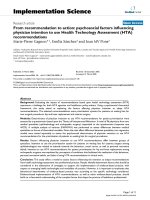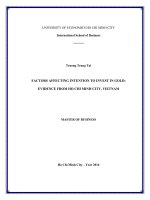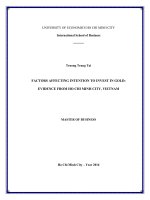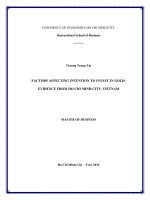Factors influencing the intention to invest in cryptocurrency of generation x, y and z in vietnam the theory of reasoned action (tra) implication
Bạn đang xem bản rút gọn của tài liệu. Xem và tải ngay bản đầy đủ của tài liệu tại đây (1.13 MB, 104 trang )
HỌC VIỆN NGÂN HÀNG
BÁO CÁO TỔNG KẾT
ĐỀ TÀI THAM DỰ CUỘC THI “SINH VIÊN NGHIÊN CỨU KHOA HỌC”
CẤP HỌC VIỆN NGÂN HÀNG NĂM 2021-2022
FACTORS INFLUENCING THE INTENTION TO INVEST IN
CRYPTOCURRENCY OF GENERATION X, Y AND Z IN VIETNAM:
THE THEORY OF REASONED ACTION (TRA) IMPLICATION
LĨNH VỰC: TÀI CHÍNH
CHUYÊN NGÀNH: TÀI CHÍNH
Hà Nội, Tháng 5 Năm 2022
Tai ngay!!! Ban co the xoa dong chu nay!!! 17014126213921000000
THÔNG TIN SINH VIÊN THỰC HIỆN ĐỀ TÀI
1. Tên đề tài: Factors Influencing the Intention to Invest in Cryptocurrency of
Generation X, Y and Z in Vietnam: The Theory of Reasoned Action (TRA)
implication
2. Lĩnh vực: Tài chính
3. Chuyên ngành: Tài chính
4. Giáo viên hướng dẫn: T.S Phạm Mạnh Hùng
5. Sinh viên/nhóm sinh viên thực hiện đề tài:
ĐH
Họ và tên
STT
Mã số SV
Lớp
Khoa
năm
thứ
1
1
2
2
F12-065
D
Tài chính – Ngân Hàng
Liên Kết Quốc Tế, Đại
4
Học Sunderland
Tài chính – Ngân Hàng
Bùi Thị Sắc Yên
F12D
Liên Kết Quốc Tế, Đại
4
Học Sunderland
3
3
Lị Đồn Mai Hương
F12
Tài chính – Ngân Hàng
Bùi Khánh Linh
F12D
Liên Kết Quốc Tế, Đại
Học Sunderland
4
3
ABSTRACT
This study was completed to investigate the effects of personal factors on Vietnamese
people's intention to invest in cryptocurrency. Although it is not widely known and there
are no specific regulations and laws on cryptocurrency-related transactions in Vietnam,
many articles and studies show that the cryptocurrency market in Vietnam is constantly
developing. Particularly, in 2021, Vietnam was identified as a lead country in global
cryptocurrency adoption. Specifically, according to a new report about cryptocurrency
published by Finder, Vietnam has 20% of people who claim to have invested in Bitcoin and
other crypto-assets. In addition, data from Statista indicates that, of the 74 economies
surveyed, Vietnam has the second-highest rate of cryptocurrency usage among the surveyed
countries. These numbers show that the investment trend in cryptocurrency is growing
continuously in Vietnam, especially among the middle-aged generation and Gen Z young
people (Techinasia.com, 2022). The study investigated 201 people living in Vietnam and
contacted them through an online form to record their answers. This study uses the PLSSEM method and applies TRA to achieve the goal of investigating the intention to invest
in cryptocurrency in Vietnam. The results show that Attitude and perceived usefulness have
a positive effect on the intention to invest in cryptocurrency.
4
Table of Contents
LIST OF FIGURE ......................................................................................................................... 6
LIST OF ABBREVIATION ......................................................................................................... 7
CHAPTER 1: INTRODUCTION ................................................................................................ 8
1.1.
Research Background ................................................................................................. 8
1.2.
Identify the issue .......................................................................................................... 8
1.3.
Research Question ....................................................................................................... 9
1.4.
Scope ............................................................................................................................. 9
1.5.
Access............................................................................................................................ 9
1.6.
Research ethics .......................................................................................................... 10
1.7.
New contributions ..................................................................................................... 10
1.8.
Research structure .................................................................................................... 11
CHAPTER 2: LITERATURE REVIEW .................................................................................. 12
2. Theoretical background ................................................................................................... 12
2.1.
Cryptocurrency, block chain and investment in cryptocurrency ......................... 12
2.2.
Variables’ definitions ................................................................................................ 15
2.3.
Hypothesis development ........................................................................................... 18
Research model framework ................................................................................................ 29
CHAPTER 3: METHODOLOGY ............................................................................................. 31
3.1.
Research approach ....................................................................................................... 31
3.2.
Sampling method .......................................................................................................... 32
3.3.
Variables’ resources and measurement ...................................................................... 33
3.4.
Descriptive analytics ..................................................................................................... 34
3.5.
Method ........................................................................................................................... 35
CHAPTER 4: FINDINGS ........................................................................................................... 37
4. Research model ................................................................................................................. 37
4.1.
Descriptive analytics ................................................................................................. 37
4.2.
Variables’ descriptive analytics ............................................................................... 40
4.3.
Measurement analysis ............................................................................................... 48
CHAPTER 5: DISCUSSION ...................................................................................................... 57
5. Discussion about the impact of perceived risk on the intention to invest in
cryptocurrency ......................................................................................................................... 57
5.1. Discussion about the impact of perceived risk on the intention to invest in
cryptocurrency ...................................................................................................................... 57
5.2. Discussion about the impact of perceived usefulness on the intention to invest in
cryptocurrency ...................................................................................................................... 58
5
5.3. Discussion about the impact of perceived enjoyment on the intention to invest in
cryptocurrency ...................................................................................................................... 59
5.4. The relationship between government regulation and intention to invest in
cryptocurrency ...................................................................................................................... 61
5.5. Discussion about the relationship between Attitude and intention to invest in
cryptocurrency ...................................................................................................................... 62
5.5. Discussion about the relationship between subjective norms and intention to invest
in cryptocurrency .................................................................................................................. 63
CHAPTER 6: CONCLUSION AND RECOMMENDATION ................................................ 68
6.1.
Conclusion ..................................................................................................................... 68
6.2.
Limitations ..................................................................................................................... 69
6.4.
Recommendation .......................................................................................................... 70
Reference list ............................................................................................................................ 72
Appendix I. Survey .................................................................................................................. 86
Appendix II: Coded survey..................................................................................................... 95
6
LIST OF FIGURE
Figure 1: Research model framework ................................................................................ 30
Figure 2: Research model ................................................................................................... 37
LIST OF TABLE
Table 1: Previous study about cryptocurrency and block chain ......................................... 13
Table 2: Variables’ resources and measurement ................................................................ 34
Table 3: Gender’s descriptive analytics ............................................................................. 38
Table 4: Generation descriptive analytics .......................................................................... 38
Table 5: Education descriptive analytics ............................................................................ 39
Table 6: Starting time on cryptocurrency investment descriptive analytics ...................... 39
Table 7: Perceived risk ....................................................................................................... 40
Table 8: Descriptive analytic for Perceived Usefulness variable ....................................... 42
Table 9: Descriptive analytic for Perceived Enjoyment variable ....................................... 43
Table 10: Descriptive analytic for Government Regulations variable ............................... 44
Table 11: Descriptive analytic for Attitude variable .......................................................... 45
Table 12: Descriptive analytic for Subjective Norms variable .......................................... 46
Table 13: Descriptive analytic for Intention to invest variable .......................................... 47
Table 14: Outer loading ...................................................................................................... 48
Table 15: Cronbach's Alpha ............................................................................................... 50
Table 16: Composite reliability .......................................................................................... 51
Table 17: Average Variance Extracted (AVE) ................................................................... 51
Table 18: Heterotrait-Monotrait Ratio (HTMT) ................................................................ 52
Table 19: Path coefficients ................................................................................................. 54
Table 20: R Square ............................................................................................................. 55
Table 21: Collinearity ......................................................................................................... 56
7
LIST OF ABBREVIATION
AT
Attitude
CPU
Central Processing Unit
GR
Government regulation
IT
Intention to invest in Cryptocurrency
PE
Perceived enjoyment
PR
Perceived risk
PU
Perceived usefulness
SN
Subjective norms
TPB
Theory of Planned Behavior
TRA
Theory of Reasoned Action
8
CHAPTER 1: INTRODUCTION
1.1.
Research Background
Cryptocurrency is a digital currency, using blockchain technology and Cryptocurrencies
that are not regulated under any particular government. The former name of Cryptocurrency
when it first occurred in public was “Cyber Currencies”. Cryptocurrencies became more
famous with the occurrence of Bitcoin in 2009. An article named “Bitcoin: A Peer-to-Peer
Electronic Cash System” written by Satoshi Nakamoto self-affirmed as Bitcoin founder.
Satoshi Nakamoto stated that “We have proposed a system for electronic transactions
without counting on trust” (Nakamoto, 2008). Bitcoin is operated under blockchain
technology, specifically, in the previously mentioned article, Bitcoin works as a peer-topeer network with the ability to record public transaction history and most nodes operate
honestly under the management of powerful CPUs (Nakamoto, 2008).
The blockchain network is a decentralized operating system and does not need a third party
to act as an intermediary to process transactions. New nodes can create a new block and
other Nodes will vote based on their CPU strength as the article mentioned “They vote with
their CPU power, demonstrating their acceptance of valid blocks by working on extending
them and rejecting invalid blocks by refusal to work on them” (Nakamoto, 2008).
In 2021, Vietnam was identified as a lead country in global cryptocurrency adoption.
Specifically, according to a new report about cryptocurrency published by Finder, Vietnam
has 20% of people who claim to have invested in Bitcoin and other crypto-assets. In
addition, data from Statista indicates that, of the 74 economies surveyed, Vietnam has the
second-highest rate of cryptocurrency usage among the surveyed countries. These numbers
show that the investment trend in cryptocurrency is growing continuously in Vietnam,
especially among the middle-aged generation and Gen Z young people (Techinasia.com,
2022).
1.2.
Identify the issue
The development of Cryptocurrency in Vietnam is distinctively distinctive from other
countries although this aspect is incompletely developed. On 21st August 2017 (Tran and
9
Nguyen, 2021), the Prime Minister of Vietnam recently issued Decision No. 1255/QD-TTg
approving the project to complete the legal framework for management and handling of all
types of assets. virtual currency. until April 11, 2018, the Prime Minister issued Directive
No. 10/CT-TTg on strengthening the management of activities related to cryptocurrencies
and the cryptocurrency market (Tran and Nguyen, 2021).
It can be seen that although Vietnam has no specific legal regulations on the investment,
trading, and use of cryptocurrencies, the number of crypto holders, investors, and users of
cryptocurrencies in Vietnam is increasing. Therefore, this study will clarify the factors
affecting the intention to invest in cryptocurrencies based on TRA theory in Vietnam. From
the discussion and analysis, the result and conclusion would be drawn which related to the
trends, purposes, and intentions of young people in Vietnam in investing in
cryptocurrencies.
1.3.
Research Question
Clarifying the trends and intentions of young people in Vietnam regarding their intention
to invest in cryptocurrencies, this study will clarify the following research questions: (a)
The relationship between perceived risk, perceived usefulness, perceived enjoyment, and
government regulation to intention to invest in cryptocurrency. (b) The relationship
between perceived risk, perceived usefulness, perceived enjoyment, and government
regulation to intention to invest in cryptocurrency with the mediating role of attitude. (c)
the relationship between subjective norms to the intention to invest in cryptocurrency.
1.4.
Scope
This paper aim at studying factors having an impact on the intention to invest in
cryptocurrencies or virtual currencies among 250 Millennials and the iGen in both genders
(male and female). Besides, this study was carried out from January 2022 to May 2022,
data was collected for 2 months, from February to May 2022. The study was conducted in
Hanoi; the database is 250 participants from different provinces in Vietnam.
1.5.
Access
10
The data used in this research will be gathered through Google Form as an online survey
platform. The designed questionnaire, which is attached with the introduction of the
researchers, the aim of the paper as well as the informed consent, will be transferred to the
members of cryptocurrencies user groups in Zalo and Telegram
1.6.
Research ethics
During the implementation of this study, the researcher also needs to ensure the integrity
and the anonymity of the participants’ identities. Therefore, this study will ensure the
ethical principles of research as followed:
Informed consent: All the related information about the research (including research
purpose, the procedure, and the statement allowing respondents to ask questions or not)
need to be provided and explained comprehensively and in detail to the participants as
well as their role in the investigation.
Autonomy: The participation of the respondents is voluntary without any duress or
inappropriate inducement. This means that their rights, dignity, and autonomy should
be protected from violation.
Privacy and confidentially: Data protection should be prioritized in the research. The
information of participants must ensure to be anonymous, in which personal
information such as gender, age, or contact method should be concealed. Moreover,
collected data should be secured and stored after the research following confidential
principles.
1.7.
New contributions
This study investigates the investor's perception, along with the intermediary role of attitude
and subjective norm as control variables related to the impact on intention to invest in
cryptocurrency. This research’s findings will offer a better understanding and provide a
new perspective on Vietnam's investors' decision-making process concerning this new
emerging cryptocurrency investment. The establishment of investment intention elements
for contribution to the investment decision-making process of Vietnam individual investors
from a consumer behavior perspective is a key theory of this study. There are a lot of
11
previous studies examining the factors impacting the intention to invest in cryptocurrency,
but few have evaluated how an investor might approach this investment decision-making
from an investor standpoint. This is the first study to use consumer perception theory to
analyze investors in the context of intention to cryptocurrency investment, according to the
authors. By understanding investors' perceptions and attitudes, policymakers would be
better able to determine the need for cryptocurrency policy. In addition, this article will
provide readers with an overview and understanding of the intention to invest in
cryptocurrency in Vietnam, especially the approach to the investment intention of the Z
generation, who are considered young investors and the future of Vietnam.
1.8.
Research structure
Therefore, based on the identical problems mentioned above, this paper will first provide a
general understanding of cryptocurrencies, methodologies applied in this research, and
testing hypothesis and research model. Moreover, data and findings collected from the
respondents as well as in-depth analysis will also be included in the description of the
results.
12
CHAPTER 2: LITERATURE REVIEW
2. Theoretical background
2.1.
Cryptocurrency, block chain and investment in cryptocurrency
Cryptocurrency has been an emerging topic for many researchers and also financial
students. Behavior towards cryptocurrency is presented in different papers and articles
which have the same subject but use different methods. For example, in 2020, Albayati and
colleagues established a paper about “Acceptance of financial transactions using block
chain technology and cryptocurrency: A customer perspective approach” using The
Technology Acceptance Model (TAM) (Albayati, Kim, and Rho, 2020). in 2018, the
Theory of Planned Behavior (TBP) was applied to clarify “Cryptocurrency Adoption and
the Road to Regulation” written by Schaupp and Festa (Schaupp and Festa, 2018), TAM
was also used as the fundamental theory to be extended and examined the “An empirical
study on the adoption of blockchain-based games from users’ perspectives” written by
Shang and Ying in 2021. Recently in 2020, a paper released 2020 written by Boxer and
Thompson also used TRA as a based theory to extend their framework as TPB to research
“Herd Behavior in Cryptocurrency Markets” (Thompson, 2020).
The most recent definition of Theory of Reasoned Action stated that TRA was constructed
by Fishbein and Ajzen in 1975 is a theory established with a model that associates the
relationship among attitudes, subjective norms, intention, and behavior (Muchlis Gazali, et
al., 2018). In 2013, a paper states that TRA is a theory of cognition that presented as a
conceptual framework to express human behavior in specific aspects (LaCaille, 2013). TRA
is a fundamental theory to create the Theory of Planned Behavior (TBP) which was
extended by Ajzen in 1991 (Thompson, 2020). TBP emphasizes the understanding of the
“complexities of human social behavior” (Ajzen 1991). In the traditional TRA by Fishbein
and Ajzen, the creators separate the precedent term of behavioral intentions into two sets
which were behavioral beliefs and normative beliefs. The former is the impact of the
attitude of an individual, and the latter is normative beliefs that influence the individual’s
subjective norms about performing that behavior (Fishbein and Ajzen, 1975).
13
The study method is quantitative in the aspect of cryptocurrency and blockchain using TBP
or TRA have a significant amount of previous papers and articles.
Table 1: Previous study about cryptocurrency and blockchain
Number
Article Title
Author
Year
Theoretical
foundation
Accepting Financial
Transactions Using
1
Blockchain Technology
And Cryptocurrency: A
Customer Perspective
Hayder Albayati,
Kyoung Kim, Jae
2020
TAM
2020
TPB
2018
TBP
Jeung Rho
Approach
Muhammad Khalid
Social Media Usage And
Individuals' Intentions
2
Toward Adopting Bitcoin:
The Role Of The Theory Of
Planned Behavior And
Perceived Risk
Anser, Ghulam
Hussain Khan
Zaigham,
Muhammad Imran
Rasheed, Abdul
Hameed Pitafi,
Jawad Iqbal, Adeel
Luqman
3
Cryptocurrency Adoption
Ludwig Christian
And The Road To
Schaupp, Mackenzie
Regulation.
Festa
Osama Sohaib;
4
A PLS-SEM Neural
Walayat
Network Approach For
Hussain; Muhammad
Understanding
Asif; Muhammad
Cryptocurrency Adoption
Ahmad; Manuel
Mazzara
TRAM
(TRI and
TAM)
14
Understanding The
5
Diffusion And Adoption Of
Kyeongsik Yoo,
Bitcoin Transaction
Kunwoo Bae, Eunil
Services: The Integrated
Park, TaeyongYang
TPB, IDT,
2020
benefit-cost
concept
Approach.
Testing Impact Of Personal
Innovativeness On Intention Nguyen Thi Lien
To Invest In
6
HUONG, Nguyen
Cryptocurrency Products Of Thi Lam OANH, and
2021
TPB
2019
TPB
Duwi Agustina
2019
ETAM
Minseong Kim
2021
TPB
2020
TRA
Vietnamese People: An
Ha Nguyen Ngoc
Extension Of Theory Of
LINH
Planned Behavior (Tpb)
Predicting Fintech
7
Innovation Adoption In
South Africa: The Case Of
Cryptocurrency
Last Mazambani and
Emmanuel
Mutambara
Extension Of Technology
Acceptance Model (Etam):
8
Adoption Of
Cryptocurrency Online
Trading Technology
A Psychological Approach
To Bitcoin Usage Behavior
9
In The Era Of COVID-19:
Focusing On The Role Of
Attitudes Toward Money
10
Herd Behaviour In
Michael Boxer, Nik
Cryptocurrency Markets
Thompson
15
An Empirical Study On The
11
Adoption Of BlockchainBased Games From Users’
Shang Gao, Ying Li
2021
TAM
2021
TPB
2021
TAM3
Perspectives
Examining The Intention
13
To Invest In
Quoc Trung Pham,
Cryptocurrencies: An
Hiep Hai Phan,
Extended Application Of
Matteo Cristofaro,
The Theory Of Planned
Sanjay Misra and
Behavior On Italian
Pier Luigi Giardino
Independent Investors
Factors Influencing The
Behavioural Intention To
Use Cryptocurrency In
Emerging Economies
14
During The COVID-19
Pandemic: Based On
Technology Acceptance
Model 3, Perceived Risk,
Prapatchon
Jariyapan, Suchira
Mattayaphutron,
Syeda Noorzahrah
Gillani and Owais
Shafique
And Financial Literacy
2.2.
Variables’ definitions
2.2.1. Perceived risk
Perceived risk refers to an uncertain decision of a consumer to use or purchase a product
and to bear the consequences of this decision. Any decision made will cause results that are
not anticipated with certainty or can be undesirable (Bauer, 1960). According to Genner et
al., 2003, the perceived risk is defined as the result of a selection reflecting the between its
end consequence, and the potential to which it is insecure to innovate. Risky and insecurity
are the main reasons for people's concern about adopting new technology (Worthington and
Edwards, 2000; Pikkarainen et al., 2004). The lack of trust and possible negative impact on
16
consumers can occur in decision-making in the context of uncertainty (Faqih, 2016). In
other words, perceived risk relates to thoughts and beliefs about the possibility of
undesirable outcomes or consequences associated with the pursuit of expected
consequences of evolving cryptocurrencies (Khedmatgozar & Shahnazi, 2017). Regarding
risk, three components negatively affect the decision: privacy risk, financial risk, and
security risk. Privacy risk refers to the privacy information of someone, and financial risk
mentions the cost and may incur additional costs (Bhatnagar and Ghose, 2004). Security
risk is related to unfacilitated losses associated with cryptocurrencies. Furthermore,
predicting the use and adoption of technology is considered a perceived risk (Pham et al.,
2021).
2.2.2. Perceived usefulness
The term perceived usefulness can be understood as the trustfulness of a person that using
certain technologies might enhance his or her working efficiency (Davis, 1989). Therefore,
this means a system that has a high degree of perceived usefulness would be chosen by
users as they have a belief in the positive outcomes. The author also indicated that a type
of technology is considered to have a high degree of perceived usefulness by users only
when it could improve job performance.
On the other hand, Doan and Luu (2016) believed that once people are aware of the benefits
that technology brings about, they would have positive attitudes and tend to use them in the
future more frequently. They also found that once users are concerned about the application
of technology beneficial in terms of time-saving, effort reduction, and convenience, there
would be the possibility of an increase in acceptance and intention to adopt this technology
in the future. Additionally, the PU construct considers the influence of the technology on
individuals’ productivity and it directly impacts their attitude, their intention to use as well
as practical technology usage (Camilleri, 2019)
2.2.3. Perceived enjoyment
Perceived enjoyment can be understood as the extent of internal motivation, which
highlights the joyfulness and the pleasure obtained from a specific activity (Balog and
17
Pribeanu, 2010). In another way, this term is a psychological perception originating from
the information technology context. Moreover, a person perceives enjoyment as a
derivative of activity when he or she sees it as enjoyable itself, excluding any expected
repercussion in terms of efficiency (Winarno et al., 2021). Previous studies had concluded
that the perceived enjoyment of a person toward the technology would affect their intention
and frequent use of the technology (Venkatesh and Bala, 2008). In other words, when the
technology gives individuals convenience and enjoyment during their usage, the interest
will be manifested and stimulated, hence, driving their intention to reuse for inherent joy.
The enjoyment can be measured from people’s experience of using e-platform. Therefore,
the PE constructs become important and indispensable for identifying the intention to apply
technology in the future (Lai and Ahmad, 2015).
2.2.4. Government regulation
As potential revolution alternates the exchange of money way, the expanding
cryptocurrency market into global venues faces challenges and potential risks as the
universal recognition of virtual currencies is not popular as an official payment system for
goods and services, development of standardized systems for their use is vital (Farell,
2015). To ensure sustainable currencies, their legal status must be introduced. Regulatory
systems are developing that governments take with various approaches. Current regulatory
measures stand in their infancy and constantly evolve in the rapidly developing industry.
Regulations bring legitimacy to a currency struggling to achieve mass approval. The
elements of the market will be standardized and minimize volatility. While regulatory steps
are tested amalgam by the government, their core purpose is similar to fraud minimization,
consumer protection, respecting economic sanctions, and instituting viable taxation policies
(Mbarek et al., 2019).
2.2.5. Attitude
To the earliest definition of Attitude, a mentalist stated that “attitudes” are a “mental and
neural state of readiness” (Allport, 1935). In 1991, Ajzen mentioned that attitude toward a
behavior is a construction of psychology that describes a person’s emotional and mental
18
entity (Ajzen, 1991). Ajzen also stated that attitude is an evaluation of individuals from
being unfavorable or favorable to implement the action or the behavior (Ajzen, 1991). In
2013, “attitude” was defined as evaluated with sematic differential scales that comprehend
and approach both affective and cognitive attitudes (Gellman, 2020).
2.2.6. Subjective norms
Fishbein and Ajzen stated that subjective norms are the perception and opinion of a close
individual, companion, or fellow on a particular subject and that conception will affect the
behavior of an individual (Ajzen, 1991). Subjective norms are also known as the intangible
standard on a specific aspect in different backgrounds and societies. Therefore, Individuals
are under social pressure to perform or not perform certain behaviors (Ajzen, 1991). In
2010, Puschel et al. said that close relationships such as family, friends, and people in the
same community or society will exert pressure on an individual's decisions about behavior.
(Püschel et al., 2010)
2.2.7. Intention to invest in cryptocurrency
Users were probably already familiar with other transaction services, such as stock
exchanges or mobile banking services. For example, approximately 70% of smartphone
users in South Korea employ mobile banking services (CIO, 2017). Considering the
diffusion ratio of smartphones in South Korea, users of BTSs were more likely to have used
other transaction services before trying BTSs. Thus, the complexity of the service did not
have a significant impact on user attitudes
2.3.
Hypothesis development
2.3.1. Perceived risk and the intention to invest in cryptocurrency
Behavioral intention and attitude have been demonstrated to be affected by perceived risk
(Kesharwan and Bisht, 2012). Many researchers such as Chen (2008), Tan (2009), and
Yang (2012) highlighted the vitals of both perceived risk and perceived trust consider as a
significant concern that the risk of financial loss influences whether or not payment
technology is used and adopted. Discovering the major factors in perceived risk were
security and privacy concerns (Chiristou, 2006; Tan et al., 2009). Perceived risk plays a
19
powerful factor in explaining the behavior of customers and investors because they are
more interested in avoiding loss or damage to themselves than in performing transactions
successful translation. According to Bauer (1960), perceived risks associated with the
acceptance
of
cryptocurrencies
include:
(1)
perceived
risks
associated
with
products/services and (2) perceived risks associated with transactions. The most vital
factors in a claim by the perceived risk concern related viability, safety risk, third party
service default risk and potential of illegal association, user error risk, private loss risk, and
risk of the counterparty (Nuryyev et al., 2018) An empirical study on predictors of
behavioral intention by Faquih (2016) revealed that when a customer or investor is making
a virtual currency investment transaction, there is a higher sense of risk when compared to
the behavior using cash. More than some types of studies have been researched to use
Fintech with inconsistent consequences and found the risk perceived as a factor affects its
attitude. In their research, a crucial precursor to online banking is security certificates (Khan
et al., 2017). The risk perceiving has a significant impact on mobile banking in rural
locations in terms of descriptions. The results are shown that the security, financial, and
privacy risk have influenced the intention to use online banking (Lee, 2009). Therefore, a
hypothesis is proposed as followed:
Hypothesis 1 (H1): Perceived risk has a significant effect on the intention to invest in
cryptocurrencies.
2.3.2. Perceived usefulness and the intention to invest in cryptocurrency
There were many contradictory opinions about the relationship between benefit perception
and the intention to invest in the cryptocurrency market of investors. On the one hand, the
use of cryptocurrencies affects investors’ benefits perception and their behavior was
interpreted and the results proved that there was no significant relationship between the
intention to use this blockchain platform market and the perceived benefits of users
(Alqaryouti et al., 2019)
On the other hand, others believe that people who got benefit from a particular activity or
technology might consider using it again in the future. Therefore, in the circumstances of
20
cryptocurrencies, as investors mostly tend to expect profitability, they would probably
continue to finance this type of blockchain platform when they are aware of the benefits
gained (Gazali et al., 2018). Nian and Chuen (2015) had researched the cryptocurrency
case, in which Bitcoin specifically. The study evident that there are several merits that
Bitcoin users could gain such as being free to send and receive anywhere, anytime, or from
anyone. This means that users have full power to control Bitcoin transactions with very few
restrictions. Moreover, there are also some advantages that investors could gain through
this financial platform such as cost reduction, and time-saving for transactions (Chowdhury
and Mendelso, 2013). Besides that, Bitcoin in specific as well as virtual currency markets
is considered a financial platform in which the data is secured and provides a safe and
reliable source of personal and financial information (Gazali et al., 2018). As a result, the
evidence shows that users of cryptocurrency could benefit significantly from this kind of
virtual currency market, which could lead to an increase in the loyalty of investors or their
intention to invest in the future.
Moreover, in research by Teker and Deniz (2021) on investors’ perception of
cryptocurrency, it was evident that most participants were willing to invest in
cryptocurrencies due to significant return performance. This indicates that the intention to
enter this virtual currency market was affected by the fact that investors’ perception of the
benefits earned. Moreover, one of the factors for adopting Bitcoin is the expectation of
performance and effort, as users want to perceive the merits that they can earn by utilizing
this market (McMorrow and Esfahani, 2021). Therefore, a hypothesis is proposed as
followed:
Hypothesis 2 (H2): There is a significant relationship between perceived usefulness and
the intention to invest in cryptocurrency
2.3.3. Perceived enjoyment and the intention to invest in cryptocurrency.
In information systems research, perceived enjoyment, or it can be conceptualized as
hedonic motivation, had been proved to influence the technology acceptance, which
directly affects the technology usage of people (Thong et al., 2006 Alaklabi and Kang,









